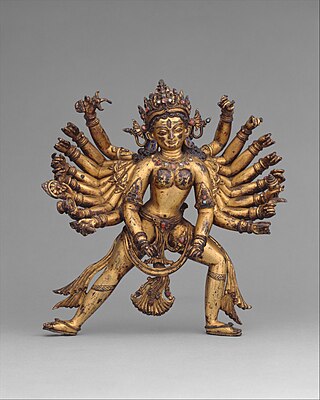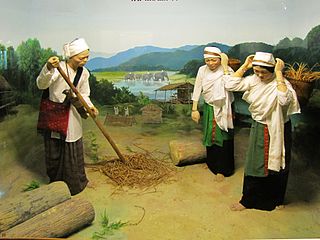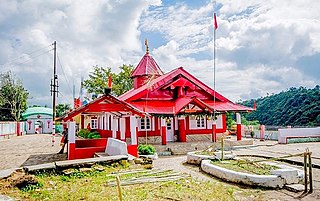Related Research Articles

A demon is a malevolent supernatural entity. Historically, belief in demons, or stories about demons, occurs in folklore, mythology, religion, and literature; these beliefs are reflected in media including comics, fiction, film, television, and video games. Belief in demons probably goes back to the Paleolithic age, stemming from humanity's fear of the unknown, the strange and the horrific. In ancient Near Eastern religions and in the Abrahamic religions, including early Judaism and ancient-medieval Christian demonology, a demon is considered a harmful spiritual entity that may cause demonic possession, calling for an exorcism. Large portions of Jewish demonology, a key influence on Christianity and Islam, originated from a later form of Zoroastrianism, and was transferred to Judaism during the Persian era.

Meghalaya is a state in northeast India. Meghalaya was formed on 21 January 1972 by carving out two districts from the state of Assam: (a) the United Khasi Hills and Jaintia Hills and (b) the Garo Hills. The estimated population of Meghalaya in 2014 was 3,211,474. Meghalaya covers an area of approximately 22,429 square kilometres, with a length-to-breadth ratio of about 3:1.

Vijayadashami, more commonly known as Dussehra, and also known as Dasara or Dashain, is a major Hindu festival celebrated every year at the end of Durga Puja and Navaratri. It is observed on the tenth day of the month of Ashvin, the seventh in the Hindu lunisolar calendar. The festival typically falls in the Gregorian calendar months of September and October.

Setsubun is the day before the beginning of spring in the old calendar in Japan. The name literally means 'seasonal division', referring to the day just before the first day of spring in the traditional calendar, known as Setsubun; though previously referring to a wider range of possible dates, Setsubun is now typically held on February 3, with the day after – the first day of spring in the old calendar – known as Risshun. Both Setsubun and Risshun are celebrated yearly as part of the Spring Festival in Japan. Setsubun was accompanied by a number of rituals and traditions held at various levels to drive away the previous year's bad fortunes and evil spirits for the year to come.
The central and eastern Alps of Europe are rich in folklore traditions dating back to pre-Christian times, with surviving elements originating from Germanic, Gaulish (Gallo-Roman), Slavic (Carantanian) and Raetian culture.

Gawai Dayak is an annual festival and a public holiday celebrated by the Dayak people in Sarawak, Malaysia on 1 and 2 June. Sarawak Day is now celebrated on July 22 every year. Gawai Dayak was conceived of by the radio producers Tan Kingsley and Owen Liang and then taken up by the Dayak community. The British colonial government refused to recognise Dayak Day until 1962. They called it Sarawak Day for the inclusion of all Sarawakians as a national day, regardless of ethnic origin. It is both a religious and a social occasion recognised since 1957.

Jowai is the headquarters of the West Jaintia Hills district of the state of Meghalaya, India, and is home to the Pnar, a sub-tribe of the Khasi people. It is located on a plateau surrounded on three sides by the Myntdu river bordering Bangladesh to the south. Due to its high altitude of 1365 m above sea level, Jowai experiences warm summers with cool to chilly winters.

Water festivals are vibrant celebrations that occur across the globe, often marking the start of a new year or season. These festivals are deeply rooted in cultural and religious traditions, and they showcase the importance of water as a life-giving resource. In Asia, countries like Thailand, Laos, Myanmar, Cambodia, and the Xishuangbanna Prefecture region of China celebrate their respective new years with lively water festivals such as Songkran, Bunpimay, Thingyan, and Chaul Chnam Thmey. These festivities involve the joyous splashing of water, symbolizing purification and renewal. Beyond Southeast Asia and China, other countries have their own unique water-themed celebrations, from the Holi festival of colors in India to the Water Battle of Spain. These festivals serve as a reminder of the universal significance of water in our lives and our connection to it.

Dashain or Bada'dashain, also referred as Vijaya Dashami in Sanskrit, is a major Hindu religious festival in Nepal and the Indian states of Sikkim, West Bengal, Assam, South India, and Sri Lanka. It is also celebrated by Hindus of Nepal and elsewhere in the world, including among the Lhotshampa of Bhutan and the Burmese Gurkhas of Myanmar. The festival is also referred as Nauratha, derived from the Sanskrit word for the same festival Navaratri which translates to Nine Nights. A version of this festival is celebrated as Navaratri, Navaratri is not exactly the same as Dashain.

The Tai Khamti, also known as the Hkamti Shan or simply as Khamti, are a Tai ethnic group of India, China and Myanmar. The Tai-Khamti are followers of Theravada Buddhism. The Tai-Khamti have their own script for their language, known as 'Lik Tai', which originated from the Shan (Tai) script of Myanmar. Their mother tongue is known as Khamti language. It is a Tai language, closely related to Thai and Lao.
This is an overview of festivals and observances found in the Okinawa Islands, Okinawa Prefecture of southwestern Japan. The Okinawan culture is noted for extreme diversity. The following list is based on south-central Okinawa, and may not be applied to northern Okinawa. Miyako and Yaeyama hold substantially different festivals and observances.
Ethnic minorities of Bangladesh or loosely termed minority people of Bangladesh are ethnic minorities in Chittagong Hill Tracts (southeastern), Sylhet Division (northeastern), Rajshahi Division (west), and Mymensingh Division (north-central) areas of the country. They are assumed as ethnic group and the tribal races, total population of ethnic minorities in Bangladesh was estimated to be over 2 million in 2010. They are diverse ethnic communities including Tibeto-Burman, Austric and Dravidian people.

Bohag Bihu or Rongali Bihu also called Xaat Bihu is a traditional ethnic festival celebrated in the Northeastern Indian state of Assam and other parts of Northeastern India by the indigenous ethnic groups of Assam, and marks the beginning of the Assamese New Year. The festival is of mostly aboriginal origin comprising Tibeto-Burman and Tai elements. It usually falls in the 2nd week of April, historically signifying the time of harvest. Every year it falls on the 14th day of April. The holiday unites the different native communities of Assam regardless of their backgrounds and promotes the celebration of ethnic diversity.

Chinese New Year, or the Spring Festival, is a festival that celebrates the beginning of a new year on the traditional lunisolar Chinese calendar. Marking the end of winter and the beginning of spring, observances traditionally take place from Chinese New Year's Eve, the evening preceding the first day of the year, to the Lantern Festival, held on the 15th day of the year. The first day of Chinese New Year begins on the new moon that appears between 21 January and 20 February.

Phallus paintings in Bhutan are esoteric symbols, which have their origins in the Chimi Lhakhang monastery near Punakha, the former capital of Bhutan. The village monastery was built in honour of Lama Drukpa Kunley who lived at the turn of the 16th century and who was popularly known as the "Mad Saint" (nyönpa) or “Divine Madman” for his unorthodox ways of teaching, which amounted to being bizarre and shocking. These explicit paintings have become embarrassing to many of the country's urbanites, and this form of folk culture is informally discouraged in urban centers as modern Abrahamic cultural norms of shaming the human body and sexuality have spread in Bhutan's urban centers.
The Kundum festival is celebrated by the Ahanta and Nzema people of the Western region of Ghana. It is celebrated to thank God for the abundance of food at the time of the harvest period of the area.
Here is a list of glossary of culture of India in alphabetical order:

Gaan-Ngai is a festival of the Zeliangrong people of Assam, Manipur and Nagaland states in North Eastern India. Gaan-Ngai is a festival of light, celebrating the victory of light over evil and the commemoration of the coming of light or fire. It is a post harvest festival celebrated to thank the God Tingkao Ragwang for a good harvest season and heralds the beginning of a new year. The festival is celebrated for five days with various rituals, prayers and festivities such as music, dance and feast accompanying the same.

Hinduism is a minority religion in the Meghalaya state of India constituting 12% of the state's population. The Nartiang Durga Temple in Meghalaya is one of the 51 Shakti peethas on Earth and is considered by Hindus of Meghalaya as the permanent abode of Goddess Durga. Hinduism is a popular religion practice by Rabhas, Hajongs, Kochs, Rajbongshis, Mikirs, Bengalis, Nepalis, Biharis etc.
References
- ↑ "Behdienkhlam festival, driving off cholera". Enroute. 27 June 2002. Retrieved 1 November 2023.
- 1 2 3 "Behdienkhlam festival". Meghalaya tourism. Retrieved 1 November 2023.
- 1 2 3 4 "Behdienkhlam". Government of Meghalaya . Retrieved 1 November 2023.
- 1 2 "Behdienkhlam 2022: Date, history, significance and all you need to know about Meghalaya's harvest festival". Hindustan Times . 13 July 2022. Retrieved 1 November 2023.
- 1 2 3 "All About The Behdienkhlam Festival Of Meghalaya". Outlook traveller. 11 July 2023. Retrieved 1 November 2023.